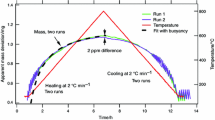Abstract
A wide variety of liquid streams are generated as part of the process research and development effort. Frequently these streams are drummed off, either as intermediates that must be held for processing or as wastes that must be sent off-site for disposal. Because of the long times and low concentrations often involved, current thermoanalytical techniques were inadequate to detect the potential of streams to generate gas. A custom-made apparatus, the gas evolution test cell (GETC), was developed in the Merck Research Laboratories to measure the gas generation potential of various streams under precisely defined conditions, is the key innovation for the development of a quantitative gas-generation test method.
Similar content being viewed by others
References
N Sax et al. (1979) Dangerous Properties of Industrial Materials, 5th Ed. Van Nostrand-Reinhold New York 726
JH Sun XR Li K Hasegawa GX Liao (2004) J. Therm. Anal. Cal. 76 883 Occurrence Handle1:CAS:528:DC%2BD2cXkvFGgt7Y%3D Occurrence Handle10.1023/B:JTAN.0000032272.60526.7c
H. Fauske, FAI Process Safety News, Spring 2005, Vol. 12, pp. 4–5.
Author information
Authors and Affiliations
Corresponding author
Rights and permissions
About this article
Cite this article
Vickery, T.P., Lam, T. Development of a new analytical method for the evaluation of hazards from slow decomposition of waste streams and process solutions. J Therm Anal Calorim 85, 239–243 (2006). https://doi.org/10.1007/s10973-005-7358-4
Received:
Accepted:
Published:
Issue Date:
DOI: https://doi.org/10.1007/s10973-005-7358-4




